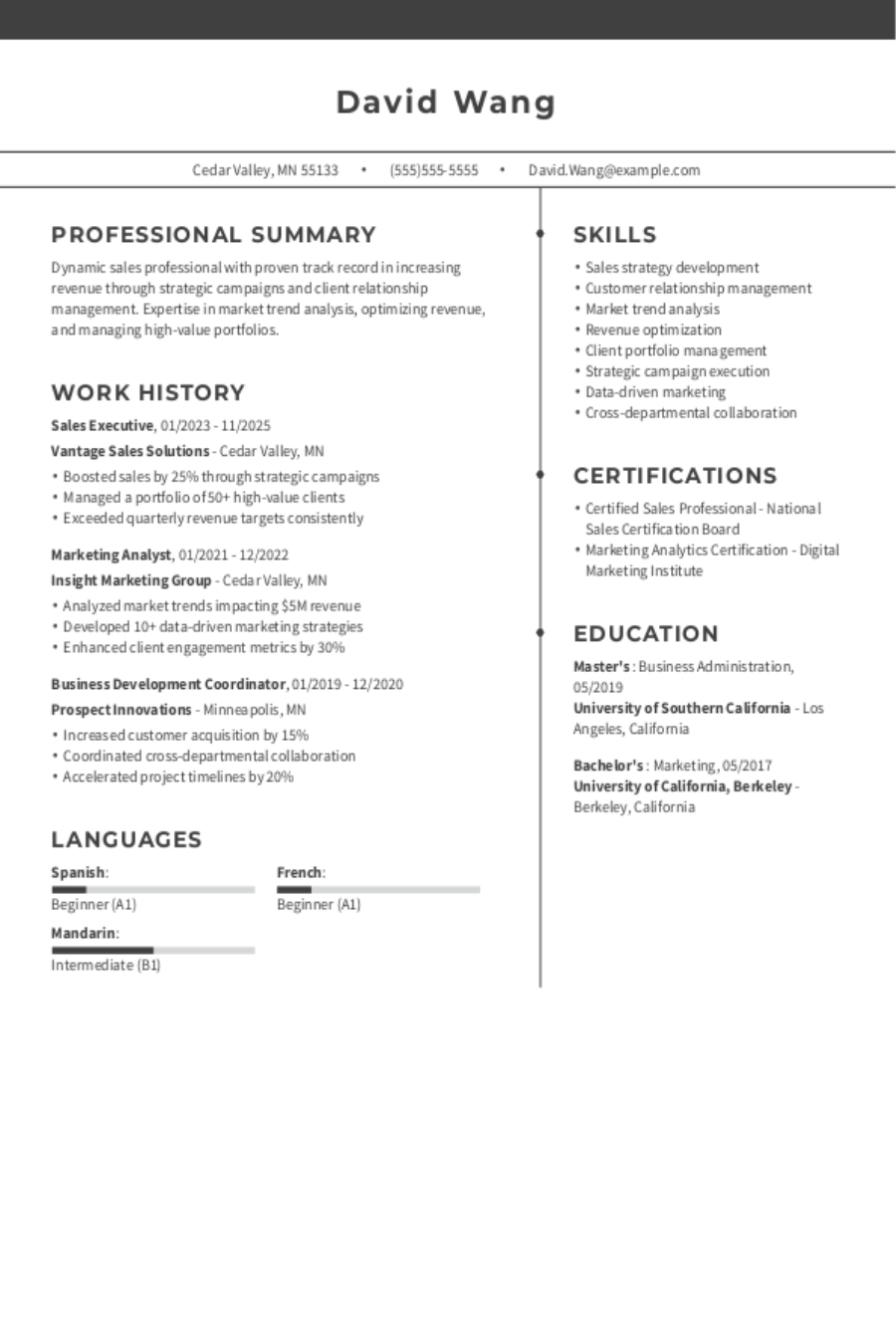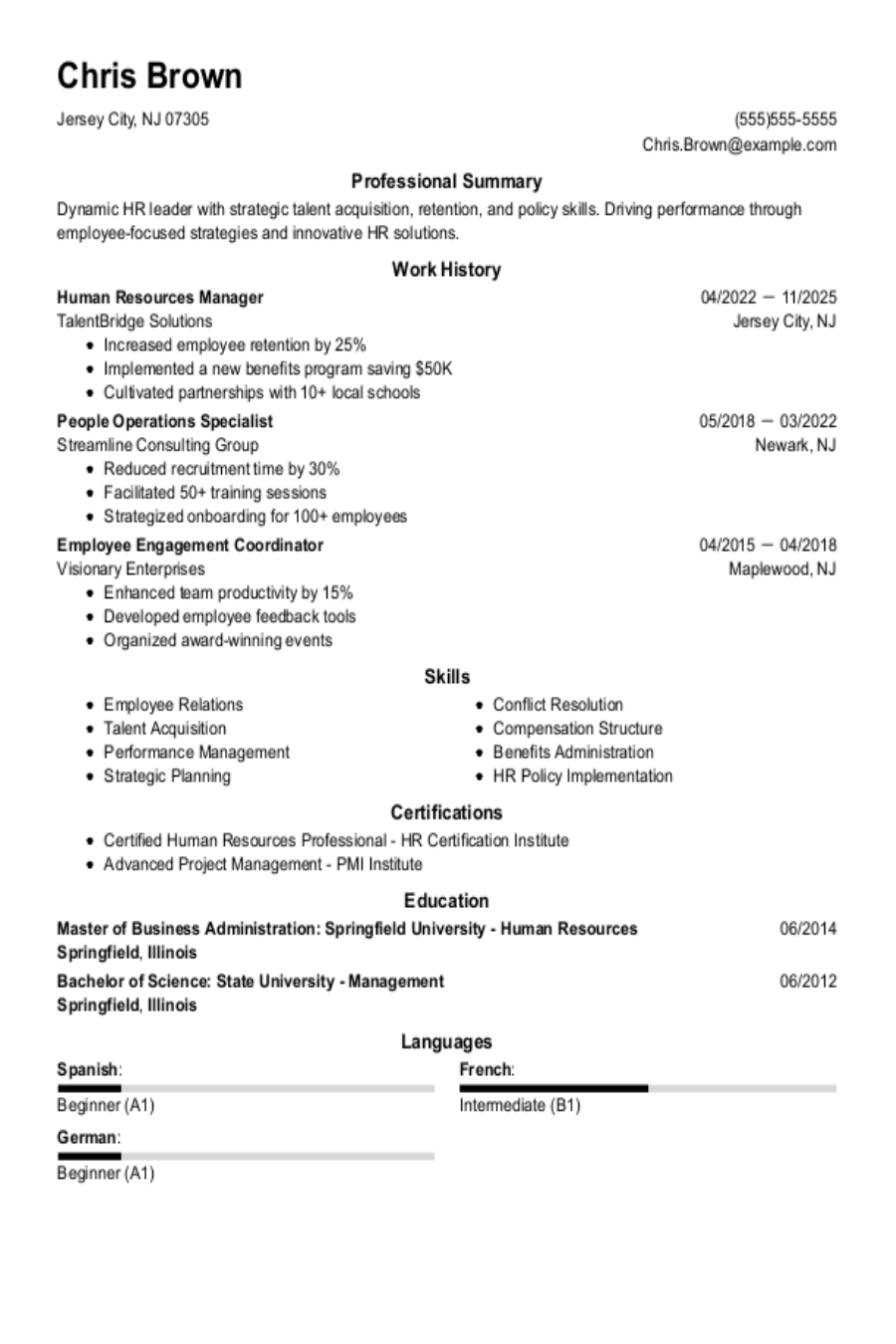Popular Stationary Engineer Resume Examples
Entry-level stationary engineer resume
An entry-level resume for a stationary engineer should focus on technical skills, relevant certifications, safety training, and practical experience through internships or apprenticeships to demonstrate capability despite limited work history.
Showcases education: This resume strengthens the candidate’s credibility by prominently displaying their educational qualifications.
Focuses on goals: With a strong foundation in mechanical engineering and energy management, this resume shows that the job seeker is focused on improving system efficiencies and professional growth through certifications and continued learning opportunities.
Mid-career stationary engineer resume
A mid-career stationary engineer resume should effectively showcase a combination of technical expertise, hands-on experience, and career advancement to appeal to prospective employers in the industry.
Balances skills and experience: This job seeker's resume effectively showcases a mix of technical expertise in HVAC systems and a clear trajectory of career advancement, demonstrating their commitment to energy efficiency and operational excellence.
Employs active language: Using action verbs such as "managed," "conducted," and "implemented" demonstrates initiative and measurable results, emphasizing a proactive approach to engineering challenges.
Experienced stationary engineer resume
An experienced stationary engineer resume should emphasize technical skills, certifications, and notable projects to effectively highlight career achievements and growth in the field.
Quantifies achievements: Quantifiable achievements, such as cost savings or efficiency improvements, provide tangible evidence of a job seeker's impact. This clarity helps recruiters quickly grasp the applicant's contributions and potential value to their organization.
Optimized for ATS: The resume uses a clean and structured template that merges a professional header with an ATS-friendly resume format, ensuring effective communication with both hiring managers and automated systems.
No experience stationary engineer resume
A resume for an applicant with no experience should highlight relevant technical skills, training, and any hands-on projects to showcase the applicant's potential and commitment to the field.
Avoids jargon: Many job seekers are tempted to use complex language to convince employers of their expertise. This resume demonstrates the strengths of a clear and straightforward approach.
Overcomes lacking experience: Incorporating volunteer roles highlights practical skills and dedication, providing valuable insights into a job seeker's abilities beyond formal work experience.
More resume examples
Stationary Engineer Resume Template
Looking to create an impressive resume? Start with this tailored stationary engineer template, which you can easily personalize with your own details and achievements.
Danielle Ross
Jersey City, NJ 07304
(555)555-5555
Danielle.Ross@example.com
Professional Summary
Innovative Stationary Engineer with 8 years in energy management, optimizing HVAC and boiler systems. Proven track record in enhancing efficiency and reducing operational costs through strategic maintenance and system upgrades.
Work History
Stationary Engineer
Energy Solutions Corp - Jersey City, NJ
September 2021 - October 2025
- Managed HVAC systems, cutting energy use by 15%
- Oversaw boiler maintenance, reducing downtime by 30%
- Optimized system performance, improving efficiency
Mechanical Systems Specialist
GreenTech Facilities - Maplewood, NJ
August 2017 - August 2021
- Enhanced system reliability, decreasing repairs by 20%
- Implemented safety protocols, zero accidents reported
- Aligned operations with environmental standards
Maintenance Technician
Prime Facility Services - Maplewood, NJ
October 2015 - July 2017
- Conducted regular inspections, boosting uptime by 50%
- Streamlined workflow, reducing operational costs
- Improved technical documentation accuracy
Skills
- HVAC systems optimization
- Boiler maintenance
- Energy management
- Technical documentation
- Safety protocols
- Mechanical systems troubleshooting
- Efficiency improvement
- Environmental compliance
Certifications
- Certified Energy Manager - Association of Energy Engineers
- OSHA Safety Certification - Occupational Safety and Health Administration
Education
Master of Science Mechanical Engineering
University of Illinois Urbana-Champaign, Illinois
June 2015
Bachelor of Science Mechanical Engineering
Illinois State University Normal, Illinois
June 2013
Languages
- Spanish - Beginner (A1)
- German - Beginner (A1)
- French - Beginner (A1)
Writing Your Stationary Engineer Resume
You've seen some effective resume examples, and now you're ready to dive into the detailed process of how to write a resume. We'll walk you through each section step by step.
List your most relevant skills
An effective skills section on your stationary engineer resume should highlight both technical abilities, such as knowledge of HVAC systems and boiler operations, and essential soft skills like teamwork and communication. This balance will demonstrate that you possess the comprehensive skill set necessary for success in the role.
To maximize your chances with recruiters and applicant tracking systems (ATS), make sure to incorporate keywords from the job listing. Terms like "preventive maintenance" or "safety protocols" can help ensure your resume aligns well with what employers are seeking. By doing this, you not only catch the attention of hiring managers but also increase your visibility within ATS, allowing you to stand out among other applicants.
Example of skills on a stationary engineer resume
- Proficient in operating and maintaining various types of boilers and HVAC systems
- Strong understanding of safety protocols and regulations in engineering environments
- Capable communicator with effective collaboration skills
- Analytical thinker with a focus on troubleshooting and problem resolution
Highlight your soft skills on your resume. While technical expertise is essential, interpersonal abilities are invaluable and often difficult to develop, making them a significant asset for potential employers.
Highlight your work history
Your work experience section should highlight not just your job functions, but also your achievements. Focus on showcasing how you applied your skills to improve efficiency or solve problems in past positions, ensuring that each entry reflects significant contributions you've made.
When detailing each job, include essential information such as your title, the employer’s name, and the dates of employment. This helps employers quickly assess your background and establishes your credibility in the field.
Example of a stationary engineer work experience entry
- Stationary Engineer
ABC Energy Solutions - Houston, TX
January 2019 - Present - Operate and maintain high-pressure steam boilers, ensuring optimal efficiency and safety standards are met at all times
- Conduct regular inspections on mechanical systems to identify issues before they escalate, reducing emergency downtime by 30%
- Implement preventive maintenance schedules that increased equipment lifespan by 25% while minimizing repair costs
- Collaborate with engineering teams to optimize energy usage, resulting in a 15% reduction in operational expenses annually
- Train junior engineers on safety protocols and equipment operation, fostering a culture of safety and competence within the team
Focus on crafting resume bullet points that highlight your key accomplishments. Aim for clarity by using action verbs and quantifiable results, ensuring each point is succinct yet compelling to showcase your skills effectively.
Include your education
The education section of your stationary engineer resume should be organized in reverse-chronological order, starting with the most recent degree or certification. Include relevant diplomas and degrees while excluding your high school diploma if you possess a higher-level qualification. Structuring this section effectively helps focus on your most relevant educational achievements, which can make a strong impression on potential employers.
If you are currently enrolled in an educational program or have not completed your studies, list your highest attained level along with an expected graduation date. Including bullet points that highlight key coursework or academic accomplishments related to stationary engineering is also beneficial.
Common certifications for a stationary engineer resume
- Stationary Engineer Certification (SEC) – National Institute for Certification in Engineering Technologies (NICET)
- Certified Energy Manager (CEM) – Association of Energy Engineers (AEE)
- Refrigeration Operator License – Local State Licensing Board
- Boiler Operator License – Local State Licensing Authority
Sum up your resume with an introduction
Your resume profile is your chance to grab attention right from the beginning. It serves as an engaging introduction that outlines your career and sets the tone for what employers can expect from you.
For seasoned job seekers, a professional summary is often the best choice. This option allows you to highlight significant accomplishments and relevant expertise upfront, providing hiring managers with a quick snapshot of your qualifications. If you’re lacking extensive experience, write a resume objective that shows your focus on career advancement.
Professional summary example
Dedicated stationary engineer with over 8 years of experience in optimizing the performance of heating, cooling, and power systems. Demonstrated success in maintaining equipment reliability while reducing operational costs through proactive maintenance practices. Highly proficient in system diagnostics, energy management, and regulatory compliance measures.
Resume objective example
Enthusiastic stationary engineer eager to use strong problem-solving abilities and mechanical aptitude to improve operational efficiency in a progressive facility. Committed to applying effective troubleshooting skills and attention to detail to contribute to team success and ensure safe equipment performance.
For a stationary engineer position, your resume profile plays an important role in making a strong first impression. Focus on incorporating relevant keywords from the job description to highlight your skills and experiences. This strategic approach not only improves your visibility but also helps ensure your resume gets past ATS systems that many employers rely on to filter job seekers.
Add unique sections to set you apart
Improve your resume by including optional sections that highlight your unique qualifications as a stationary engineer. These sections allow you to present skills and experiences that set you apart from other job seekers.
By adding details about relevant hobbies or volunteer work, you can illustrate your commitment to the field and demonstrate how your values align with those of potential employers. This not only showcases your technical expertise but also reveals aspects of your personality and work ethic, providing a fuller picture of who you are as a professional.
Three sections perfect for a stationary engineer resume
- Technical Skills: Technical skills are essential on your resume as they showcase your expertise and ability to operate complex machinery. Highlighting these skills demonstrates your readiness for the role of a stationary engineer and sets you apart from other applicants.
- Tools and Platforms: In today’s engineering landscape, showcasing your computer skills is essential. Highlight your expertise in automation systems, building management software, and energy management tools to demonstrate your capability and improve operational efficiency.
- Professional Certifications: Certifications are essential for stationary engineers, showcasing your expertise and dedication. They validate your skills and keep you updated with industry standards, improving your career prospects.
5 Resume Formatting Tips
- Choose a format that matches your career stage.
When selecting a resume format, consider your experience. If you have extensive work history, opt for a chronological layout to highlight your progression. For those just starting out or changing careers, a functional style can emphasize skills over job titles. A combination option works well if you want the best of both worlds.
- Pick a smart resume template.
To improve the clarity of your resume, consider using a resume template. This approach allows your qualifications to stand out while ensuring easy readability. If you opt for a custom format, stick to clear layouts and use fonts that are compatible with applicant tracking systems.
- Select an appropriate font.
Select a clear and professional font to improve resume readability. Fonts like Helvetica, Georgia, or Garamond are great options to ensure your document appeals to both ATS software and hiring managers.
- Use consistent formatting.
Ensure your resume features uniform margins and is aligned to the left. This creates a clean, organized look that improves readability and professionalism.
- Keep your resume to one or two pages.
When crafting your resume, remember that resumes should be one page long unless you have extensive experience. Focus on presenting relevant information clearly and concisely to make a strong impression without overwhelming the reader.
Tools for Your Job Search
Are you ready to advance your career as a stationary engineer? Before submitting your application for that coveted position, it’s essential to use our ATS Resume Checker. This tool provides valuable insights into how well your resume performs with the automated systems many employers use for initial applicant screening.
If you're looking for tailored support, our AI Resume Builder can help. It offers personalized content recommendations specific to your engineering background and includes professionally designed templates that ensure your skills and experiences stand out to hiring managers.
Frequently Asked Questions
Last Updated: November 5, 2025
Absolutely. A cover letter is important as it provides deeper insight into your qualifications and allows you to connect directly with employers. It’s your opportunity to express what draws you to the role of a stationary engineer and how your specific skills make you an ideal job seeker. Don’t overlook this chance—write a cover letter that improves your resume.
For a quick solution, consider using our AI Cover Letter Generator. It helps you create tailored, job-winning cover letters in just minutes! Plus, you can choose from various cover letter template options that align perfectly with your resume, making sure your application stands out effectively.
A resume is typically concise, spanning one to two pages, while a CV (curriculum vitae) can extend to several pages, offering detailed insights into your academic achievements, research contributions, and professional experience. This length and depth make CV templates ideal for showcasing comprehensive qualifications.
You should use a CV for applications in academia, science, law, or specialized fields where extensive detail is valued. If you’re unsure how to craft an effective CV, our online CV Maker simplifies the process. Choose from various templates tailored to different industries and career levels to create a standout document quickly and efficiently.
To write a strong CV, start by organizing your information into sections like education, experience, skills, and certifications. Select templates that are professional and work well with applicant tracking systems (ATS). Improve visibility by tailoring your content for each role using relevant keywords from the job posting.
Furthermore, examining CV examples from successful professionals in your field can provide ideas on how to showcase your accomplishments. This approach will help you grasp industry standards and inspire you to present your qualifications confidently and effectively.
To make an impressive stationary engineer resume, select a polished template and integrate essential keywords from the job description. This strategy effectively showcases your qualifications and aligns you with employer expectations.
A common mistake stationary engineers make is not optimizing their resumes for ATS. To improve your chances, use a resume template that's ATS-friendly and tailor your content to align with the specific job description. This small adjustment can significantly increase your visibility to employers.
Stationary engineers typically start as assistant engineers or operators. With on-the-job experience and additional certifications, they can advance to senior engineer roles or specialize in system management and operations.
Was this information helpful? Let us know!
Hailey is a career advice writer dedicated to helping job seekers excel in their careers.
More resources

The AI Boss Effect: 97% of Workers Have Asked ChatGPT for Advice Instead of Their Manager
Resume Now s latest report explores how AI is replacing manage...

37 Unique Skills to Put on Your Resume
Trying to avoid the skills you see pop up on resumes repeatedl...

Resume Now Spotlights 14 High-Innovation, High-Growth Jobs That Pay $60K+
Resume Now s latest report highlights some of the highest payi...

Sales Resume: Examples, Templates & Tips
Planning to pursue a sales career? Let our samples templates ...

IT Resume: Examples, Templates & Tips
Our resume examples templates and writing tips will help you ...


